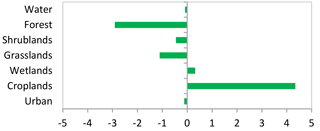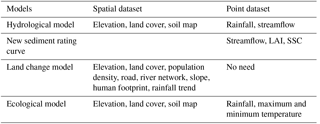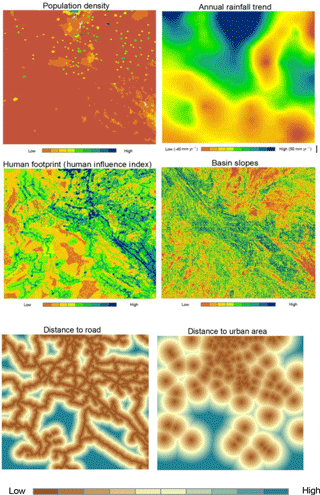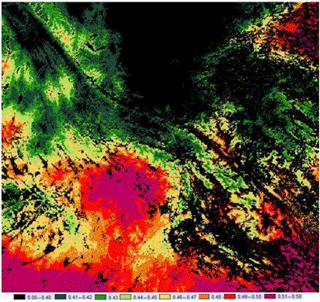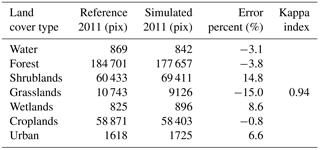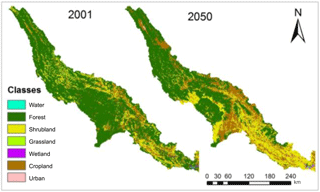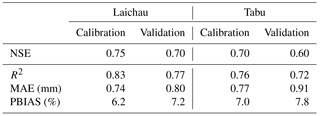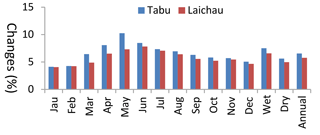the Creative Commons Attribution 4.0 License.
the Creative Commons Attribution 4.0 License.
Predicting future land cover change and its impact on streamflow and sediment load in a trans-boundary river basin
Hao Wang
Shaowei Ning
Ishidaira Hiroshi
Sediment load can provide very important perspective on erosion of river basin. The changes of human-induced vegetation cover, such as deforestation or afforestation, affect sediment yield process of a catchment. We have already evaluated that climate change and land cover change changed the historical streamflow and sediment yield, and land cover change is the main factor in Red river basin. But future streamflow and sediment yield changes under potential future land cover change scenario still have not been evaluated. For this purpose, future scenario of land cover change is developed based on historical land cover changes and land change model (LCM). In addition, future leaf area index (LAI) is simulated by ecological model (Biome-BGC) based on future land cover scenario. Then future scenarios of land cover change and LAI are used to drive hydrological model and new sediment rating curve. The results of this research provide information that decision-makers need in order to promote water resources planning efforts. Besides that, this study also contributes a basic framework for assessing climate change impacts on streamflow and sediment yield that can be applied in the other basins around the world.
- Article
(4102 KB) - Full-text XML
- BibTeX
- EndNote
Studies on hydrological processes in a changing environment have been the focus of hydrological science in the 21st century. The geographic extent of land cover change worldwide has undergone tremendous change in the past years. It has been pointed out land cover change is a major driving force in degradation of natural environment, such as more frequent incidents of local flooding, increasing soil erosion (García-Ruiz et al., 2008).
The research of the impact of land cover change on hydrological condition of the catchment area has therefore received increasing considerable attention from both field observations and model simulations (Brown et al., 2005). However, most studies have been performed on the impact of land cover change on streamflow (Zheng et al., 2009) or sediment yield itself (Leh et al., 2013), few researches were related to impact of land use change on both streamflow and sediment load (Tang et al., 2011; Dao and Suetsugi, 2014). Consequently, it is of great importance to predict future land cover change and its effects on combined streamflow and sediment flow in an effort to optimize the use of water resources and prevent reservoir siltation in Red river basin.
The overall objective of this study is to investigate changes in streamflow and sediment load response to future land cover change in the target river basin. For this purpose, future scenario of land cover change is developed based on historical land cover changes and land change model (LCM). And future leaf area index (LAI) is simulated by ecological model based on the future land cover scenario. Then future land cover change scenario is used to drive a distributed hydrological model to forecast the impact of the predicted land use change on streamflow. And scenarios of future land cover change and LAI and new sediment rating curve model to assess the impact of the future land use change on sediment load into Hoabinh reservoir. A methodology is developed in which the land change model and ecological model are coupled with a calibrated a distributed hydrological model and sediment simulation model. This coupling is new and essential for evaluating effects of land cover change on streamflow and sediment load, required for providing information that decision-makers need in order to promote water resources planning efforts.
2.1 Study Area Description
The Da River Basin (DRB) located in humid region is the biggest branch of the Red River which gets its name from the reddish-brown color caused by its high sediment load rich in iron dioxide. The DRB drains 55 000 km2, originates in Yunnan Province, China (Fig. 1). The river cross sections are narrow, with a steep slope of 0.37. The annual mean runoff is about 1168 m3 s−1 from 1988 to 2004 at Laichau station, associated with the total annual sediment load about 40.1×106 t yr−1. The Da River basin is characterized by a tropical monsoonal. Summer season is warm and humid, whereas the winter season is cool and dry (Le et al., 2007; Dang et al., 2010). The annual mean rainfall is about 1320 mm for the Da River basin, 85 % of which falls during wet rainy season. The HoaBinh reservoir, located on the downstream of Laichau station, is one of the largest (V=9.5 km3) and highest (120 m) dams in South-East Asia. It was completely finished in 1993, with the main purpose of flood control, irrigation and hydropower generation (Le et al., 2007).
2.2 Dataset Description
Daily streamflow data and Monthly suspended sediment concentration (SSC) data at Laichau (LC) and Tabu (TB) stations in DRB (Fig. 1) were used in hydrological simulation. Daily meteorological data of 14th stations well distributed are obtained from the China Meteorological Data Sharing Service Center, which has been checked by the primary quality control. All datasets above covering 1991–2000 were used as inputs for hydrological simulation and sediment load calculation. A series of geographical datasets (e.g., DEM, LAI, land cover type) were also employed in ecological simulation, hydrological simulation and land change prediction, summarized in this study (Table 1).
In this study, a group of models coupled in a “one-way” manner framework were applied. Firstly, the Land Change Modeler (LCM) was used to predict future the land cover change in the year of 2050. LCM is a powerful tool to predict future land cover change scenarios and was widely applied (Wilson and Weng, 2011). More technical details of this model could be found in the reference (Clark Labs, 2009). Then, Biome-BGC was also applied to calculate the potential LAI under future land cover changes. In our previous work, we have already described it in detailed and validated this model well in DRB (Wang and Ishidaira, 2013). So in this research this validated Biome-BGC model would be applied to predict future LAI under future land cover scenario directly.
Table 3Future land cover changes of 2050 created through neural networks compared with the baseline map of 2001 image in DRB (area percent: %).
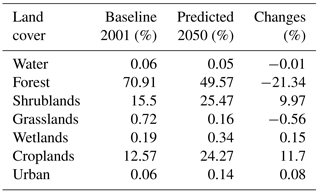
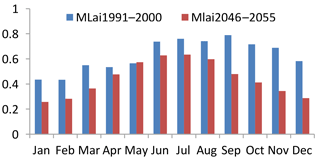
Figure 6Comparison between current average LAI (Mlai1991−2000) and future average LAI (Mlai2046−2055).
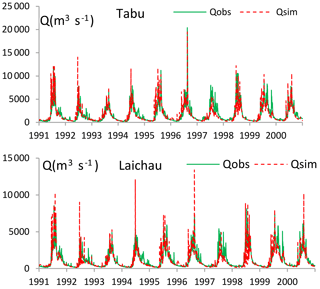
Figure 7Comparison of observed and simulated daily streamflow in the DRB (calibration period: 1991–1995, validation period: 1996–2000).
Finally, future land cover and LAI obtained above were used to drive hydrological and sediment simulation model. The hydrological model “Blockwise use of TOPMODEL with Muskingum–Cunge routing” (BTOPMC), a grid-based distributed hydrological model developed by University of Yamanashi, Japan (Takeuchi et al., 1999; Ao et al., 2003), was applied in river flow simulation. And sediment simulation model considering vegetation cover (LAI) which has already been developed and could give better agreement simulation result in several Asian basins (Wang et al., 2013; Wang and Ishidaira, 2013), was used to simulate SSC in DRB.
4.1 Future land cover and LAI prediction
Land cover changes between year of 2001 and 2008 were calculated firstly by land change modeller, which showed that cropland increased and forest decreased obviously. So the increase in cropland mainly came from forest changes (Fig. 2). In addition, six driving factors (Fig. 3) which may affect land cover changes and land cover changes obtained above were introduced to build up potential land cover transition maps by multi-layer perceptron neural network method. For example, transition possibilities map from forest to croplands in Fig. 4 shows that there is a high possibility in the bottom and center of our basin.

Figure 9Changes in streamflow and sediment load under land cover changes in 2050 at Laichau station.
Land cover map of 2011 simulated by LCM based on potential land cover transition maps showed an agreement spatially with actual land cover map of 2011. Additionally, high kappa index (Jensen, 1996) and low mean error between simulated and observed land cover maps in 2011 was calculated (Table 2), which indicated that simulated map had a good match with the reference one. So LCM was proved to have the ability to simulate land cover changes well, then we apply it to predict future land cover map of 2050 (Fig. 5 and Table 3). Comparison of the land cover maps for 2001 and 2050 reveals that that forest area would have an obvious decrease of about 26 % and croplands have an increase of 11.7 % in 2050 compared with 2001.
Finally, Biome-BGC model which has already been validated well in DRB (Wang and Ishidaira, 2013) was driven by future land cover of 2050 to predict future LAI in the period of 2046 to 2055. Results (Fig. 6) showed that future LAI would decrease especially for dry season due to deforestation.
4.2 Hydrological and sediment simulation
As shown in Tables 4 and 5, all statistics indicated that BTOPMC hydrological model and sediment simulation model could give a better simulation results in river flow and SSC, and simulated hydrograph also has a good match with the observed (Fig. 7). Results above comprehensively explained that BTOPMC and sediment model can simulate streamflow and SSC accurately.
4.3 Future land cover change impacts
Predicted land cover map, LAI data and fixing the climatic conditions were used to drive the validated hydrological and sediment simulation models to investigate future land cover change impacts on streamflow and sediment load. Changes in streamflow in upstream and downstream are illustrated in Fig. 8, which indicate that land cover change affect streamflow stronger in the downstream of DRB. As shown in Fig. 9, the effects of future land cover change would increase sediment load by 9.6 %, while the change rates in streamflow were within 5.7 %. Sediment load was found more sensitive to land cover change than streamflow. As for seasonally variations of stream flow and sediment load caused by land cover changes, changes in streamflow and sediment load were more pronounced during the wet season.
Other factors such as model parameters may lead to not realistic results in our study. To reduce uncertainty in model simulation, more field observations should be done.
In this study, one framework to evaluate future land cover change effects on streamflow and sediment load was developed and successfully applied in Da River Basin. Generally, the streamflow and sediment yield will increase in 2050s under land cover change. Streamflow and sediment load increase in 2050s emphasize the importance of building adaptation to land cover changes to avoid flood and soil erosion. The results obtained in this study could be useful for the appropriate utilization of water resources, flood control, soil conservation and ecological protection in this region by enhancing the understanding of the impact of land cover change scenarios on streamflow and sediment yield.
-
Daily meteorological and hydrological data from 1991 to 2000 were obtained from the hydrological stations and precipitation stations from China Meteorological Data Sharing Service Center and Vietnam Academy of Science and Technology which is considered confidential.
-
Digital elevation data (GTOPO30) is obtained from the flowing URL: https://lta.cr.usgs.gov/GTOPO30 (last access: 16 May 2017)
-
Soil type data is obtained from the flowing URL: http://www.fao.org/soils-portal/soil-survey/soil-maps-and-databases/harmonized-world-soil-database-v12 (last access: 15 December 2017)
-
Land cover data from 2001 to 2011 is obtained from the flowing URL: https://modis-land.gsfc.nasa.gov/ (last access: 10 June 2017)
-
Global roads dataset and global Human Footprint (HF) are obtained from the flowing URL: http://sedac.ciesin.columbia.edu/ (last access: 15 June 2017)
-
Monthly TRMM satellite rainfall data (TRMM_3A12) are obtained from the flowing URL: https://pmm.nasa.gov/data-access/downloads/trmm (last access: 15 May 2017).
The authors declare that they have no conflict of interest.
This article is part of the special issue “Innovative water resources management – understanding and balancing interactions between humankind and nature”. It is a result of the 8th International Water Resources Management Conference of ICWRS, Beijing, China, 13–15 June 2018.
This research was supported by the National Natural Science Foundation of
China (Grant No. 41501029) and the Startup Foundation for Introducing Talent
of NUIST. The authors are also thankful to China Meteorological Data Sharing
Service Center for providing the hydro-meteorological data.
Edited by: Depeng Zuo
Reviewed by: Kai Ma and one anonymous referee
Ao, T., Takeuchi, T., Ishidaira, H., Yoshitani, J., and Fukami, K.: Development and application of a new algorithm for automated pits removal for grid DEMs, Hydrol. Sci. J., 48, 985–997, 2003.
Brown, A. E., Zhang, L., Mcmahon, T. A., Western, A. W., and Vertessy, R. A.: A review of paired catchment studies for determining changes in water yield resulting from alterations in vegetation, J. Hydrol., 310, 28–61, 2005.
CIESIN: Center for International Earth Science Information Network, Columbia University, Environmental Treaties and Resource Indicators (ENTRI) Query Service, Palisades, NY: NASA Socioeconomic Data and Applications Center (SEDAC), available at: http://sedac.ciesin.columbia.edu (last access: 15 June 2017), 2013.
Clark Labs: The Land Change Modeler for Ecological Sustainability, IDRISI Focus Paper, Clark University, Worcester, MA, 2009.
Dang, T. H., Coynel, A., Orange, D., Blanc, G., Etcheber, H., and Lan, A. L.: Long-term monitoring (1960–2008) of the river-sediment transport in the Red River Watershed (Vietnam): temporal variability and dam-reservoir impact, Sci. Total Environ., 408, 4654–4664, 2010.
Dao, N. K. and Suetsugi, T.: The responses of hydrological processes and sediment yield to land-use and climate change in the Be River Catchment, Vietnam, Hydrol. Process., 28, 640–652, 2014.
FAO: FAO/UNESCO Soil Map of the World, available at: http://www.fao.org/soils-portal/soil-survey/soil-maps-and-databases/harmonized-world-soil-database-v12 (last access: 15 Dec 2017), 2011.
García-Ruiz, J. M., Regüés, D., Alvera, B., Lana-Renault, N., Serrano-Muela, P., Nadal-Romero, E., Navas, A., Latron, J., Martí-Bono, C., and Arnáez, J.: Flood generation and sediment transport in experimental catchments affected by land use changes in the Central Pyrenees, J. Hydrol., 356, 245–260, 2008.
Huffman, G., Bolvin, D., Braithwaite, D., Hsu, K., Joyce, R., and NASA's Precipitation Processing Center: 3B42 RT Derived Daily Product, version 7, available at: https://pmm.nasa.gov/data-access/downloads/trmm (last access: 15 May 2017), 2015.
Jensen, J. R.: Introductory Digital Image Processing: A Remote Sensing Perspective (Second edition), Prentice Hall, Upper Saddle River, New Jersey, USA, 1996.
Le, T. P. Q., Garnier, J., Gilles, B., Sylvain, T., and Minh, C. V.: The changing flow regime and sediment load of the Red River, VietNam, J. Hydrol. 334, 199–214, 2007.
Leh, M., Bajwa, S., and Chaubey, I.: Impact of land use change on erosion risk: an integrated remote sensing, geographic information system and modeling methodology, Land Degrad. Dev., 24, 409–421, 2013.
NASA Land Processes Distributed Active Archive Center: USGS Products, Digital elevation data (GTOPO30), available at: https://lta.cr.usgs.gov/GTOPO30TS1, last access: 16 May, 2017.
NASA LP DAAC: The V005 MODIS Land Cover Dynamics (MCD12Q2) product, NASA EOSDIS Land Processes DAAC, USGS Earth Resources Observation and Science (EROS) Center, Sioux Falls, South Dakota, available at: https://lpdaac.usgs.gov (accessed 10 Jun 2017), 2015
Takeuchi, K., Ao, T. Q., and Ishidaira, H.: Introduction of blockwise use of TOPMODEL and Muskingum–Cunge method for the hydro-environmental simulation of a large ungauged catchment, Hydrol. Sci. J., 44, 633–646, 1999.
Tang, L., Yang, D., Hu, H., and Gao, B.: Detecting the effect of land-use change on streamflow, sediment and nutrient losses by distributed hydrological simulation, J. Hydrol., 409, 172–182, 2011.
Wang, J. and Ishidaira, H.: Effects of human-induced vegetation cover change on sediment flow using satellite observations and terrestrial ecosystem model, J. Japan Soc. Civil Eng. B1, 69, I_205–I_210, 2013.
Wang, J., Ishidaira, H., Sun, W. C., and Ning, S. W.: Development and Interpretation of New Sediment Rating Curve Considering the Effect of Vegetation Cover for Asian Basins, The Scientific World J., 2013, 154375, https://doi.org/10.1155/2013/154375, 2013.
Wilson, C. O. and Weng, Q.: Simulating the impacts of future land use and climate changes on surface water quality in the Des Plaines River watershed, Chicago Metropolitan Statistical Area, Illinois, Sci. Total Environ., 409, 4387–4405, 2011.
Zheng, H. X., Lu, Z., Zhu, R., Liu, C., Sato, Y., and Fukushima, Y.: Responses of streamflow to climate and land surface change in the Headwaters of the Yellow River Basin, Water Resour. Res., 45, W00A19, https://doi.org/10.1029/2007WR006665, 2009.







